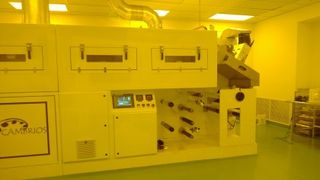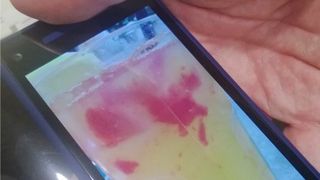The future of touchscreens revealed: bigger, cheaper, bendier
Silver is becoming the gold standard for touchscreen technology
There are half a dozen other touch sensor replacements being developed, using graphene, carbon nanobuds and other exotic materials. But few of them let through as much light as silver nanowire, or conduct as effectively.

And silver nanowire doesn't just work for touch in the lab: it's already in several shipping products, and we couldn't spot the nanowire mesh at all with the naked eye.
Cambrios' nanowires power the touchscreen in NEC's high-end Media X N-07D smartphone on the Japanese Docomo network, and the much cheaper Huawei Ascend phone on the US Sprint network. It's used in Gvision's 15-inch touchscreens that are designed to be used as paypoints on petrol pumps - which suggests it's pretty hardwearing.
LG used it for the 23-inch touchscreen V325 all-in-one that launched with Windows 8, as well as two touchscreen monitors. Intel has also used it in its 13.3-inch reference design for OEMs, which should introduce Cambrios to a wider market.
Wired for speed
LG also discovered that silver nanowires allowed it to cut out several of the usual manufacturing stages for assembling touchscreens. John LeMoncheck, CEO of Cambrios, explains that initially LG was etching the rolls of coated film as it would with an ITO sensor. However, once it realised the the nanowire solution could be sprayed on in the right pattern to start with, it was possible to reduce costs even further.
The manufacturing cost of silver nanowire touch sensor is already less than $4 per inch. With scale and shortcuts like that, LeMoncheck hopes it will drop to $3.50 or even $3 an inch next year.

Saving $1 an inch on a 5-inch smartphone screen might not make much difference to the ultimate retail price, but it could take $30-50 off bigger displays. LeMoncheck is hoping giant touchscreens like Microsoft's Perceptive Pixel monster will get much more affordable - and that they'll all be made with his silver nanowires.
Are you a pro? Subscribe to our newsletter
Sign up to the TechRadar Pro newsletter to get all the top news, opinion, features and guidance your business needs to succeed!
But there other things you could do with silver nanowires. You could coat a layer of plastic or Lucite and use that as the top layer of a really cheap screen. You can't do that with ITO because the heat needed to bake it in place would melt the plastic, but the drying oven used to fix the silver nanowires in place doesn't need to be nearly as hot (a mere 120 degrees rather than 600-plus).
It will work on an e-ink screen too. It needn't be limited to flat surfaces: you could coat a curved object like a car dashboard. You could even use silver nanowires on a flexible display, where brittle ITO would crack. Japanese touch sensor manufacturer Nissha will have 3D touch sensors this year and the company has been testing how well silver nanowire touch will work on a flexible screen.
"The coating changes in resistance. As you stretch and bend it, it goes up - but then it goes back down and comes back to normal," explained Peruvemba. So touch wouldn't work while you're bending a flexible screen, but then you probably wouldn't be trying to tap or scroll when you're folding it back up to put in your pocket.
Nissha tested a 3mm thick silver nanowire touch sensor. After bending it around a 180-degree angle 100,000 times, it was still worked every time. Add that to something like AUO's flexible e-ink screen and we're one step closer to a tablet you can roll up and put in your pocket. Bigger, slimmer and bendier: that's why the future could well be silver.
Mary (Twitter, Google+, website) started her career at Future Publishing, saw the AOL meltdown first hand the first time around when she ran the AOL UK computing channel, and she's been a freelance tech writer for over a decade. She's used every version of Windows and Office released, and every smartphone too, but she's still looking for the perfect tablet. Yes, she really does have USB earrings.
